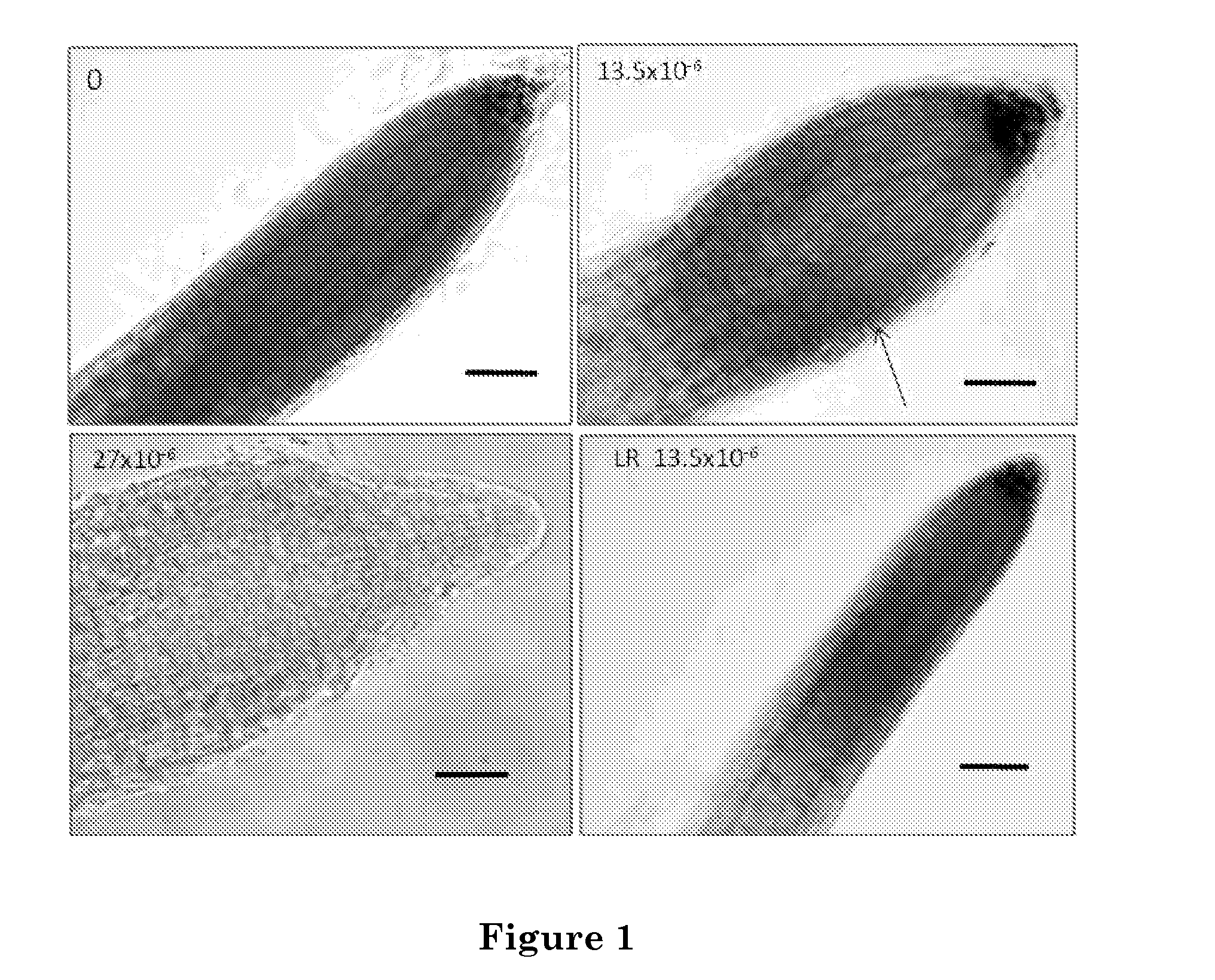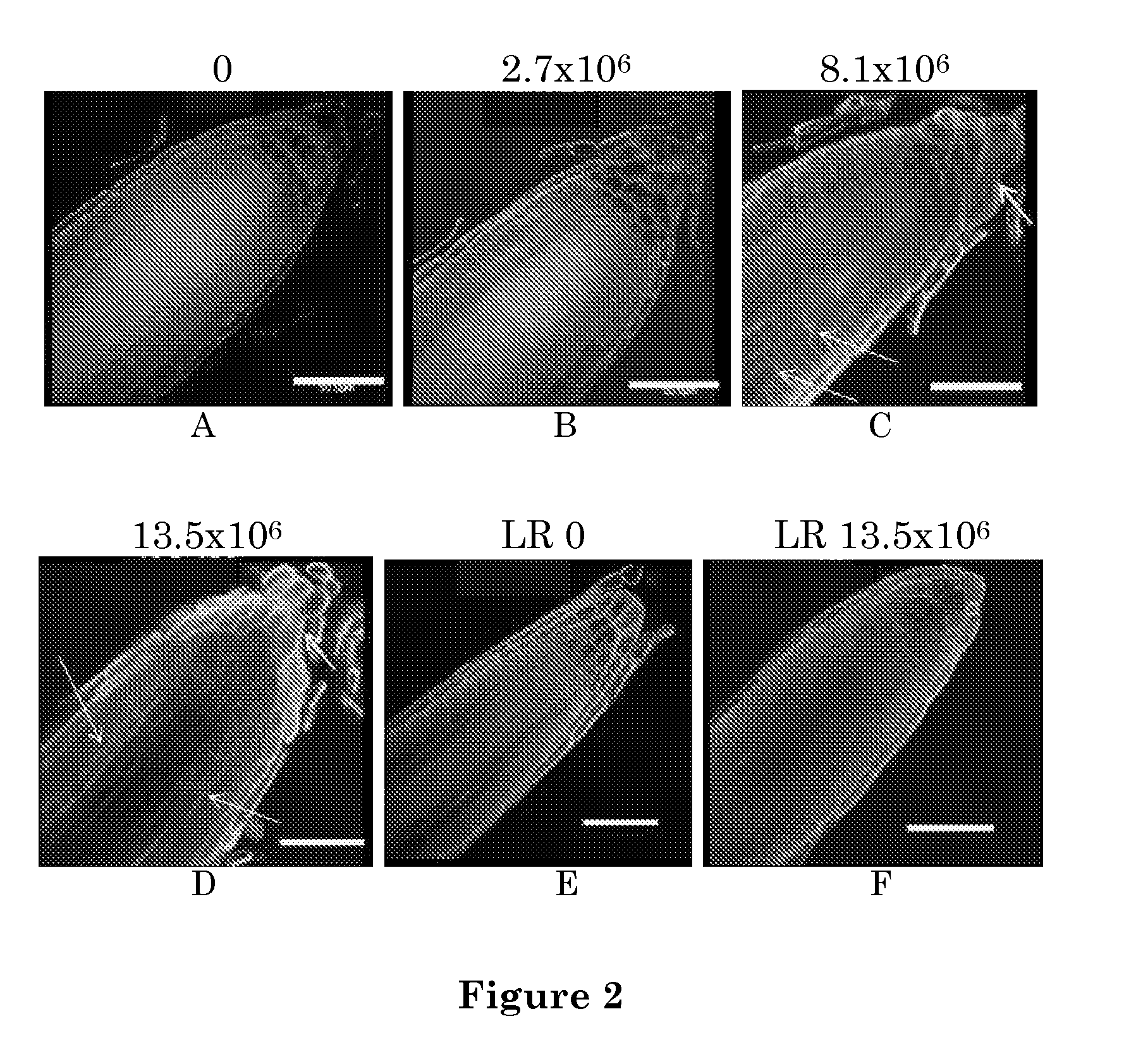Use of strigolactones and strigolactone analogs for treating proliferative conditions
- Summary
- Abstract
- Description
- Claims
- Application Information
AI Technical Summary
Benefits of technology
Problems solved by technology
Method used
Image
Examples
example 1
[0172]Germination of the Seeds of Arabidopsis thaliana
[0173]Seeds of homozygous lines of Arabidopsis thaliana wild type (WT; Columbia; Col-0) and max2-1 mutant (http: / / abrc.osu.edu / ) were surface-sterilized and germinated on ½ Murashige and Skoog (MS) plates supplemented with 1% sucrose and solidified with 0.7% agar. Plates were incubated vertically in the dark at 4° C. for two days to synchronize germination. Three days after germination, seedlings were gently transferred using forceps to ½ MS plates containing various concentrations of GR-24 as a mixture of four diastereomers: (±)-GR-24 and (±)-2′-epi-GR-24. The root tip of the transferred seedling was marked on the plates. The plates remained unsealed to prevent accumulation of gases (e.g., ethylene), and were positioned in an upright 45° position, and incubated at 22° C. with a light intensity of 50-60 mol photons m-2 s-1 provided by white fluorescent tubes and under a photoperiod of 16 hours exposure to light / 8 hours in the da...
example 2
Determination of Root-Tip Structure and Cellular Morphology
[0176]For examination of root-tip cellular morphology and starch granules in columella cells, WT roots were grown on GR-24 and control plates as described in Example 1. Following 6 days of growth on these plates, roots were stained with iodine-potassium iodide (Lugol's solution, Sigma-Aldrich Corp., St. Louis, Mo.). Concentrated Lugol's solution (5 g iodine and 10 g potassium iodide mixed with 85 ml distilled water) was used, followed by washing with double-distilled water. Using a Leica DMLB light microscope (Leica Microsystems GmbH) equipped with a Nikon DS-Fi1 camera, pictures were taken of root tips from each treatment. Experiments were repeated four times; within each treatment, four root tips were examined per experimental repeat (FIG. 1).
[0177]For examination of the order and structure of root-cap cells, WT roots were grown on GR-24 and control plates as described in Example 1. Following to 6 days of growth on said pl...
example 3
Determination of Genes Transcription Level Using Quantitative PCR
[0178]RNA was extracted from seedlings grown and treated as described in Example 1. Quantitative PCR was performed by amplifying fragments of genes of interest (Tables 6 & 7). Arabidopsis 15S ribosomal RNA (GenBank accession no. AT1G04270.1) served as the reference gene for the amount of RNA, and was amplified using specific primers (forward) 5′-CAAAGGAGTTGATCTCGATGCTCTT-3′ and (reverse) 5′-GCCTCCCTTTTCGCTTTCC-3′. The experiment was performed in 5-6 biological replicates; each replicate included 8 plants, on which 3 technical repeats were performed. Means and standard error were determined from all biological replicates.
[0179]Primers were designed using PrimerQuest software (Integrated DNA Technologies). RNA was extracted using Trizol (Invitrogen, Carlsbad, Calif., USA) using the manufacturer's protocol. 1 μg RNA was reverse-transcribed in a total volume of 20 μl using the Superscript First strand cDNA synthesis kit (I...
PUM
| Property | Measurement | Unit |
|---|---|---|
| Cell death | aaaaa | aaaaa |
| Therapeutic | aaaaa | aaaaa |
| Cell proliferation rate | aaaaa | aaaaa |
Abstract
Description
Claims
Application Information
 Login to View More
Login to View More - R&D
- Intellectual Property
- Life Sciences
- Materials
- Tech Scout
- Unparalleled Data Quality
- Higher Quality Content
- 60% Fewer Hallucinations
Browse by: Latest US Patents, China's latest patents, Technical Efficacy Thesaurus, Application Domain, Technology Topic, Popular Technical Reports.
© 2025 PatSnap. All rights reserved.Legal|Privacy policy|Modern Slavery Act Transparency Statement|Sitemap|About US| Contact US: help@patsnap.com



